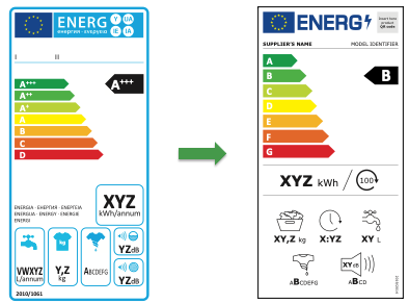New Energy Label since 1. March 2021

The European Commission has adopted revisions to several energy efficiency regulations. This includes a revised look for the well-known energy label and a tightening of the energy efficiency requirements.
The new energy labels came into effect and into shops on 1 March 2021 for the following products:
- TVs (updated) and monitors (new)
- Dishwashers (updated)
- Refrigerators and freezers (incl. wine refrigerators, minibars) (updated)
- Washing machines and washer-driers (not tumble driers) (updated)
- Commercial refrigerators with a direct sales function (new)
- Lighting products (lamps updated, luminaires new, since 1 September 2021)
The most important changes in the six new regulations are the following:
- The reintroduction of the original A-G scale and the elimination of the confusing A+, A++ and A+++ energy classes. I.e. the most efficient appliances on the market were given class A.
- A previous A+++ appliance may have an energy class of B, C or less since spring 2021. Thus, there is an incentive to develop new, more efficient appliances in the future.
- Rescaling goes along with stricter efficiency requirements. For lighting products, for example, an increased efficiency of up to 70 % can be expected.
| Category | Minimum requirements in the EU as of March, resp. September 2021 |
| Refrigerators & Freezers | min. class F |
| Washing Machines, Washer-driers | all classes permitted |
| Dishwashers | all classes permitted |
| TVs & Monitors | all classes permitted |
| Lighting (Lamps and Luminaires with integrated Lamps) | Standby not higher than 0.5 W all classes permitted |
| Ice-Cream Freezers |
min. class F |
| All other Commercial Refrigerated Appliances with a Direct Sales Function | Appliances with EEI (Energy Efficiency Index) below 100 permitted |
The design of the new energy label, here an example for washing machines:

Similar reviews or new regulations will be introduced for other categories over the next years. For the other product categories that already have an energy label, the old energy labels will remain in place for the time being.
In addition, so-called Ecodesign Regulations for these product categories have been adopted. Exciting is that they contain requirements for resource efficiency and repairability, e.g. availability of spare parts and access to repair instructions. These also came into force in March 2021.
The European energy label was first introduced over 20 years ago and is considered one of Europe's great success stories. According to Commission estimates, the total energy savings of these new labels may reach 38 TWh per year by 2030, which is equivalent to the annual electricity consumption of Hungary.
Why were there two energy labels in my newly purchased household appliance in 2021?
You bought a product in 2021 and in addition to the familiar energy label you found a second one with a different energy class and different energy consumption declarations? That is correct! Here we explain why.
To ensure that you have the correct energy label for your product from March 2021, some of the products were already delivered with the new labels even before March 2021. For this reason, there were 2 energy labels in some appliances, the old one that was still valid and the new one that would be valid after 1 March 2021.
Adjusting the Topten selection criteria to the new regulations
The selection criteria for the relevant product categories were adapted by topten.eu as soon as the new label came into effect. As always, details can be found for each category directly in the connected selection criteria and guides.
The most important criteria at the time of the entry into force of the new labels can be found in this table:
| Category | Minimum requirements for Listing on Topten |
| Refrigerators & Freezers | min. class D |
| Washing Machines <8kg | min. class D |
| Washing Machines =/>8kg | min. class B |
| Dishwashers | min. class B |
Further details, additional product categories and transitional provisions are still being specified.
Regulations
- New EU Energy Label for Lighting
- New EU Energy Label for Electronic Displays (TVs & Monitors)
- New EU Energy Label for Dishwashers
- New EU Energy Label for Refrigerators and Freezers
- New EU Energy Label for Washing Machines and Washer-Driers
- New EU Energy Label for Commercial Refrigerators with a Direct Sales Function